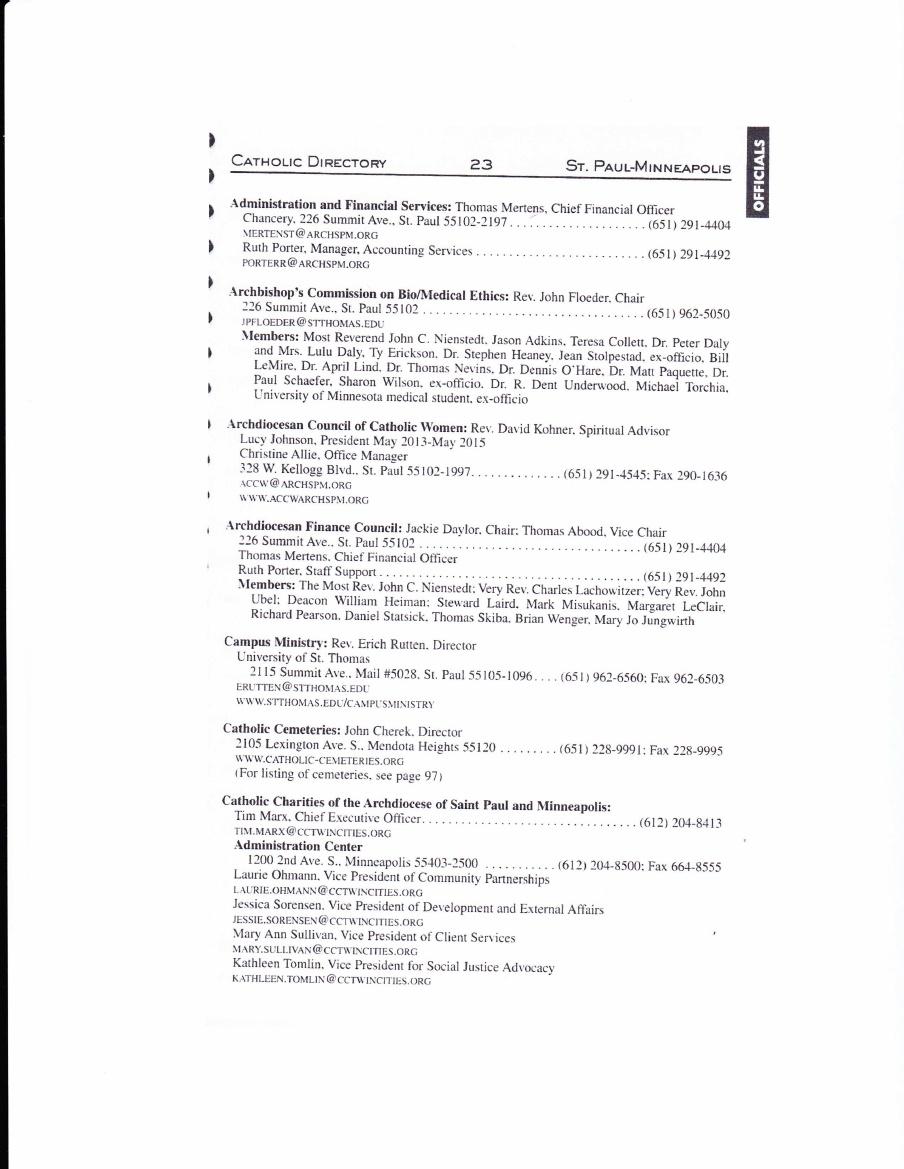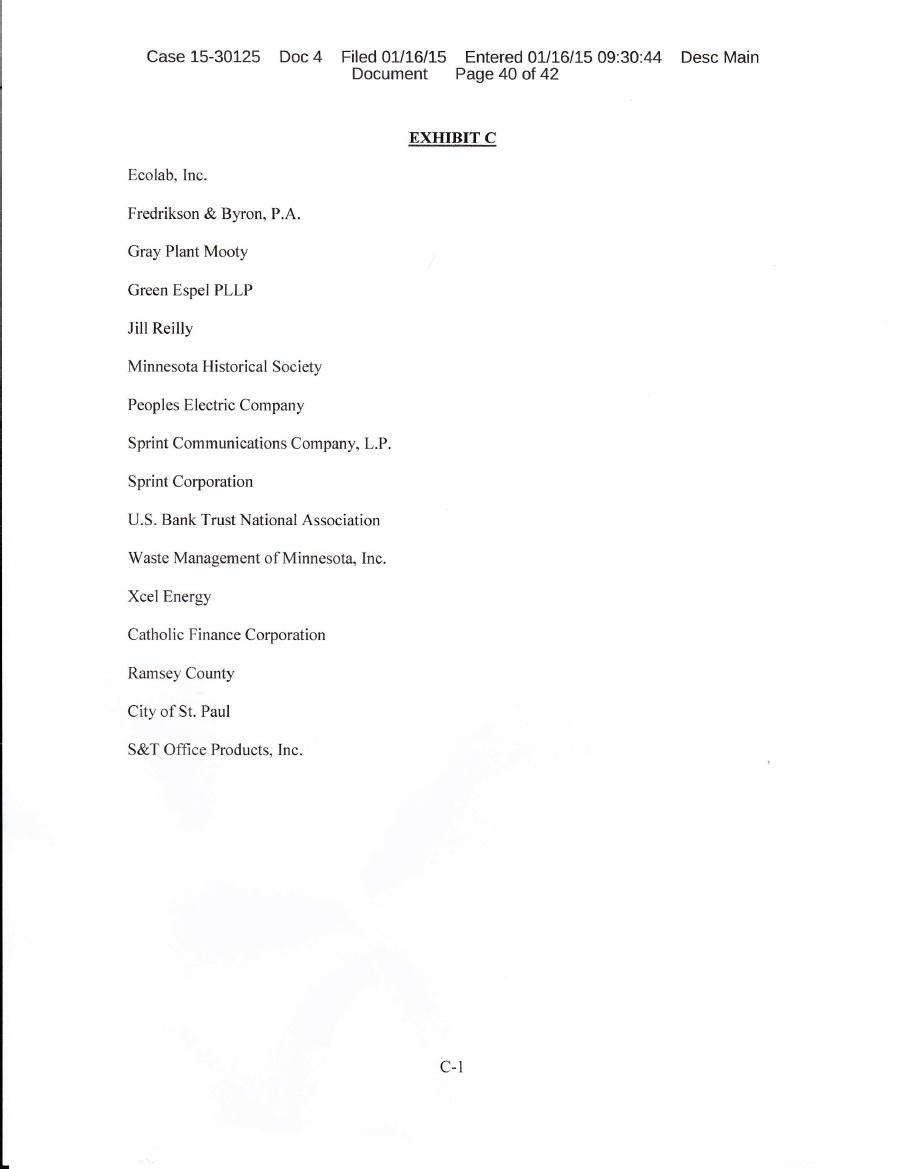|
At the very heart of the fog...
By Jennifer Haselberger
Canonical Consultation
January 17, 2015
http://canonicalconsultation.com/blog.html
 |
 |
Charles Dickens was quick to note that 'the dense fog is densest' and the mud is 'muddiest' at 'the very heart of the fog', which he identified as the High Court of Chancery. 'Chancery', in his sense and in mine, becomes somewhat of a double entendre. For, I think that anyone who watched the Archdiocese of Saint Paul and Minneapolis press conference yesterday afternoon (filmed from the Saint Paul Chancery) will agree that there was 'fog everywhere', and very little sun.
Neither the press conferences nor the documents filed as part of the Archdiocese's petition for Chapter 11 bankruptcy protection shed much light on the current situation of the Archdiocese- financially, morally, or otherwise. However, a close reading of the documents, and in particular the 'Application of the Debtor to Employ Chapter 11 Counsel' does raise some interesting questions.
1). How much has it cost?
Per the 'Verified Statement of Richard D Anderson', included as page 9 of 42 in the PDF file 'Application by Debtor', as of the date of petition (January 16, 2015) the Archdiocese has been billed by Briggs and Morgan for $900,224.11 in fees and $3281 in expenses. The billings began with the filing of an initial retainer of $300,000 on April 29, 2014, which has been periodically refreshed to maintain a minimum trust balance of $250,000. On January 13, 2015, in advance of filing the petition, the Archdiocese deposited an additional $750,000 into the trust account.
The 'Verified Statement' indicates that Briggs and Morgan billed, from this account, 'for any matter arguably related to a potential bankruptcy filing'. However, it also specifies that 'any matter' does not include fees and expenses incurred in connection with:
-
the 'voluminous' review of clergy files
-
analyses of insurance issues
-
'voluntary' public disclosures of accused clergy
-
police reporting
-
insurance coverage litigation
-
development of child protection policies and protocols
According to the 'Verified Statement', payments from the Archdiocese have been made out of its general operating fund, which goes a long way towards explaining the $9.1 million deficit that was announced in November of 2014. At that time the Archdiocese suggested that $4.1 million of that amount went towards addressing allegations of clerical sexual abuse.
2). What happened to Brian Wenger?
In bankruptcy proceedings, the proposed attorney for the debtor (in this case the Archdiocese of Saint Paul and Minneapolis) must list any potential conflicts of interest (again see the Verified Statement of Richard D. Anderson). An interesting aspect to the disclosure filed yesterday has to do with the former Chair of Briggs and Morgan, Brian Wenger. Throughout my tenure as Chancellor in the Archdiocese, Brian Wenger was an influential adviser and friend to Archbishop Nienstedt (at least to the extent that anyone could be considered a friend of the Archbishop). Wenger served as Chair of the Archdiocese Finance Council for a number of years, and was active in drawing up a plan for the reorganization of Chancery departments following the embezzlement scandal (a reorganization plan that did not include, interestingly, a Chancellors' department). The normally reclusive Archbishop would even, on occasion, have the Wenger family at his residence- a circumstance almost unheard of in other contexts. So great was Wenger's influence, in fact, the the CFO and my co-Chancellor often griped about the extent to which Wenger's advice was sought and accepted over theirs.
Because of this, I was interested to see how Briggs and Morgan responded to this potential conflict, especially given that the Archdiocesan Finance Council was, according to Archbishop Nienstedt, one of the consultative bodies that advised him to seek bankruptcy protection. I was absolutely floored, therefore, to read this in the 'Verified Statement':
'Mr. Wenger resigned from the Finance Council in October 2013. I have reviewed the minutes of meetings of the Finance Council during Mr. Wenger's tenure on it, and asked him specifically about his service on the council. To the best of my knowledge, upon such due inquiry, the Finance Council did not consider matters relating to this Chapter 11 case or to a potential Chapter 11 reorganization of the Archdiocese during Mr. Wenger's tenure on the Finance Council (pp. 5-6)'.
According to this statement, Brian Wenger resigned from the Finance Council in October of 2013, shortly after the revelations began regarding the Archdiocese's mishandling of sexual abuse by clergy. Terms on the Archdiocesan Finance Council are generally for 5 years, and run July to June. So, this certainly couldn't have been an anticipated departure. Could a rift have developed between Wenger and the Archbishop? If that is true, my respect for Brian Wenger has only increased. It seems unlikely, however, given the role that Wenger played in the hiring of Greene Espel. So then, the question becomes, did anyone tell the Archdiocese about his resignation? The 2014-2015 Minnesota Catholic Directory, published and produced by the Archdiocese after Wenger's departure, still lists him as a member (see below).
Second, if Richard Anderson is to be believed (and I have no reason to doubt him) the Archdiocesan Finance Council did not consider matters relating to a potential Chapter 11 reorganization prior to October 2013. The Minnesota Child Victims Act, which opened a civil window for the filing of cases of sexual abuse that were otherwise time barred, was introduced in the Minnesota legislature on February 13, 2013. As I have already mentioned, within a month the Archdiocese had brought attorneys from the firm of Whyte Hirschboeck Dudek, who are representing the Archdiocese of Milwaukee in its bankruptcy proceedings, to speak to diocesan officials about strategy and preparation for a bankruptcy filing. Was the Archdiocesan Finance Council kept in the dark about both the meeting and the Archdiocese's anticipated exposure if the Act passed? Was the Council consulted at all about the appropriate response to the introduction of the bill or, after its passage, about the potential impact on the Archdiocese's financial outlook? Was it aware of the likely expenditures when it approved (in May-June of 2013) the budget for the fiscal year 2013-2014? If Richard Anderson is to be believed, the Archdiocesan Finance Council was kept in the dark about all of this, which might give some indication of the extent of the mismanagement that has brought the Archdiocese to the brink of insolvency.
3). Is Greene Espel a creditor?
Bankruptcy documents requiring disclosures of potential conflicts also include lists of those creditors and vendors of the debtor (the Archdiocese) to whom the representing attorney or firm (Briggs and Morgan) also provides or has provided representation. The potential creditors and debtors are listed in Exhibit C (see below). While the filing indicates that the Archdiocese is current or nearly current with its vendors, and therefore the claims of those listed are 'accordingly not considered material or likely to be disputed' (p. 21), the list in and of itself is of particular interest because of the inclusion of Greene Espel PLLP. Obviously, this inclusion does not indicate to what extent the Archdiocese has been forced to squander its already insufficient resources in investigating the conduct of the present Archbishop. However, it does serve as a useful reminder that the precarious situation of the Archdiocese (financial and otherwise) is not only due to lawsuits stemming from clergy sexual abuse in the 1960s, 1970s, and 1980s.
One final thought...
Rereading the article announcing the introduction of the bill that would become the Minnesota Child Victims Act, I was struck by the Archdiocese's response to the bill. The Archdiocese's statement, on February 13, 2013, was, and I quote:
"Since 2002, the Catholic Church has taken extraordinary measures to ensure the safety of young people in its churches and schools. Few, if any, organizations have instituted the type of measures to protect young people. In this regard, the Catholic Church is now a model for other institutions to follow in the safeguarding of our youth."
Two days later, in a memo that was introduced along with my affidavit in the Doe 1 case, Father Laird instructed me not to turn over to the police the CD-Roms of pornography belonging to Father Shelley, as I was insisting should be done, but instead to place them in a sealed box in the Chancery vault. 'Few organizations' indeed, and thank God for that.
|

